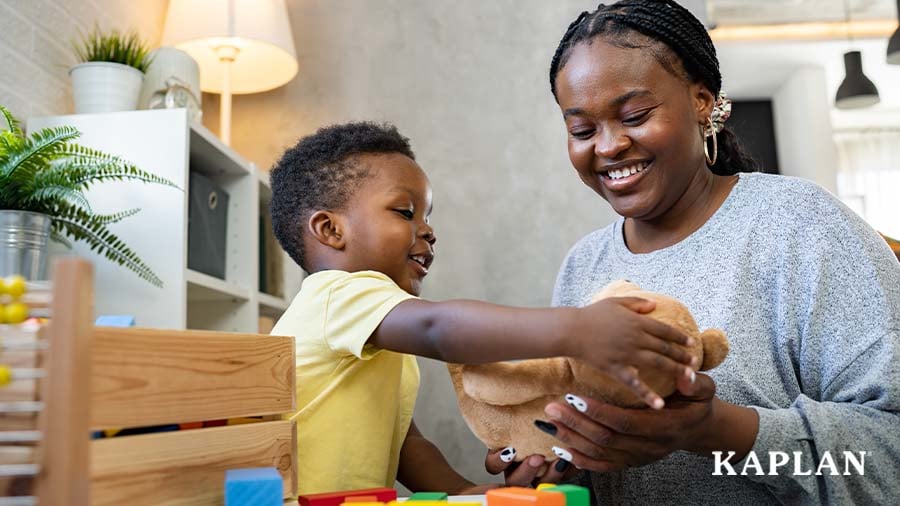Whether you teach in an early learning program or the elementary school setting, assessments are crucial tools you’ll use to monitor children’s academic, cognitive, social, and emotional development. Sharing these assessment results with parents and families is an essential step in helping children thrive in every domain.
A child’s development can be a sensitive topic for families, especially if an assessment reveals unexpected challenges or deficits. So, the way you communicate those results matters just as much as the actual scores or percentile ranks themselves. In this article, we’ve outlined seven tips for effectively sharing assessment results and strategies in a positive, actionable way that bolsters home-to-school partnerships.
How can you share assessment results with families effectively and respectfully?
Sharing assessment results requires a thoughtful approach to effectively engage and build trust with the families of children in your care. When parents and families feel seen, respected, and included in their child’s growth and development, they’re more likely to collaborate with educators and support their child’s learning journey at home.
From scheduling dedicated time with families to navigating potential disagreements, the following are a few tips for communicating assessment results in a way that fosters trust and collaboration.
1. Set up adequate time for a meaningful conversation
Communication begins before assessments take place. This allows you to explain the purpose of the assessment and how it will be conducted, as well as address any questions or concerns families may have. Once you have the results in hand, schedule dedicated time to share them with families. Parents and caregivers are often strapped for time, and it’s tempting to discuss assessment results during drop-off or pick-up to fit everyone’s busy schedule. However, assessment results are a sensitive topic that warrants careful consideration and time for discussion. Not to mention, the first rule for handling difficult conversations, as author Ginger Welch, PhD, shares in How Can I Help: A Teacher’s Guide to Early Childhood Behavioral Health, is “Respect Confidentiality.”
According to Welch, it’s best to avoid sharing assessment results within earshot of others, including the child, and to aim for a time when families and educators aren’t rushed. You may consider hosting a virtual or face-to-face family conference to allocate ample time to highlight the child’s strengths, address the family’s concerns, and propose targeted solutions for areas of need.
2. Reiterate the purpose of the assessment
Before diving into the results, take a moment to explain the purpose of the assessment. Use the time to share how the results can inform your instruction and what families can do at home to encourage further learning and support their child. Hone in on the skills the assessment observes, how those skills support children’s growth and development, and why the chosen assessment and strategies are well-suited to set their child up for long-term success.
3. Start with the child’s strengths and goals
Families may feel anxious or defensive when sitting down for a parent-teacher conference or when hearing assessment results that reveal potential areas of concern. You can help ease their anxiety while fostering trust and openness by discussing the child’s strengths first. Share positive skills, behaviors, and experiences you’ve observed, and review the areas on the assessment that highlight the child’s strengths. Also, invite families to contribute to the list of strengths and share their goals for their child’s learning and development in all areas.
Another rule for handling difficult conversations, according to How Can I Help, is to address the parent or caregiver as the expert on the child. Incorporating the family's input can help prevent them from becoming defensive of assessment results or resistant to your advice. Once you’ve gone over the child’s strengths, it is time to set goals based on the assessment results and where you hope the child will be academically and developmentally by the next assessment.
4. Leverage the summary report to guide the conversation
Many early childhood and elementary assessments provide summary reports with scores, benchmarks, growth metrics, and recommendations. Summary reports help keep the conversation on track while offering families support and clarity about the results. Take it one section at a time to avoid distracting or overwhelming parents and caregivers. If they do become distracted or overwhelmed by results, try shifting the focus back to the child’s strengths and goals.
5. Explain why home and school results may differ
It’s common for parents and caregivers to disagree with assessment results, particularly if challenges or areas of need don’t reflect what they see at home. In this case, it’s important to acknowledge that a child’s behavior can vary based on the environment.
If a parent or family member strongly disagrees with your assessment results, here are some statements you can make to alleviate the tension and acknowledge the reported differences:
You might say, “Your family has a special relationship with each other. The characteristics of your home and the program differ in many ways, including the number of children, types of activities, and daily routines. We expect children’s behavior to vary depending on the setting.” Or you might say, “You have known your child for longer than I have. Tell me more about your child’s behaviors at home.”
While you may have a better understanding of the child’s behavior in an educational setting, gathering additional insight from families can help bridge the behavioral gap between home and your program or school.
6. Establish a plan for regular communication
The conversation doesn’t end once you’ve shared the assessment results. Create a schedule to exchange information regularly about the child’s experiences, interests, behavior, and progress. Start by providing a written copy of the summary report and anything else discussed in the meeting. Then, plan to connect with parents or caregivers regularly—either by phone, email, or family meetings—to keep them up-to-date and engaged with the child’s intervention or support plan.
7. Empower families to partner on a path forward
Helping children thrive in both school and home environments is a collaborative effort between you and their parents or caregivers. Be sure to send families off with helpful resources that explain the skills and behaviors observed in the assessment results. Then, conclude with encouraging words to keep them excited about working together to help promote their child’s overall growth and development.
Some children may need support that goes beyond what you can provide as a teacher, and that’s okay. In this case, use this time to connect families with the right resources. Depending on the child’s needs, additional help may include a referral for a developmental evaluation, access to early intervention support, or a consultation with a mental health specialist. Share your recommendations with care, and remind families that seeking support helps lay the foundation for their child’s future success.

Strengthening family partnerships to help children thrive at school and at home
Sharing assessment results with intention and care sets the foundation for a strong partnership with families. Consistent, coordinated home-school partnerships are key to helping children develop the skills necessary to thrive in early childhood and beyond.
Remember: There is no “one-size-fits-all” strategy when it comes to communicating and collaborating with families. How you partner with families should be unique to your program or school’s practices, your teaching style, and the needs of the children and families. Meet families where they are, and do what you feel works best for you and them to establish meaningful and collaborative family partnerships that benefit the whole child.
Ready to explore our assessment and evaluation options?
Keeping a pulse on children’s progress in early childhood helps ensure their academic, social-emotional, and physical development is on track. We offer a variety of assessment and evaluation materials to help you gather the necessary data to identify children’s individual needs, tailor their learning experiences, and adjust your program goals to support whole-child development. Explore our offerings to find the best assessment or evaluation for your program or classroom.

